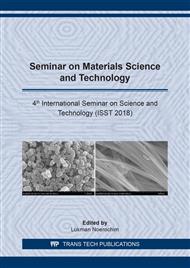p.62
p.68
p.80
p.88
p.97
p.103
p.109
p.115
p.124
Enhanced Biodiesel and Ethyl Levulinate Production from Rice Bran through Non Catalytic In Situ Transesterification under Subcritical Water Ethanol Mixture
Abstract:
In-situ transesterification method without catalysts to produce biodiesel (fatty acid ethyl esters, FAEE) from rice bran using subcritical water ethanol mixture has been investigated. This method was found to be efficient since the rice bran oil (RBO) extraction and reaction of RBO into FAEE occur simultaneously. In this process other chemical (ethyl levulinate, EL) was also formed along with FAEE. EL can be used to improve the biodiesel quality by improving the low temperature properties of biodiesel. In this study effect of co-solvent types (without co-solvent, ethyl acetate, chloroform, and n-hexane) and water ethanol ratio (20%, 40%, 50%, 60% and 80%, v/v) on the content and yield of FAEE and EL at subcritical water ethanol mixture (T= 160°C, P= 80 bar, and t= 2 h) were investigated systematically. The content and yield of FAEE and EL obtained was found to be affected by the type of co-solvent. The content of FAEE and EL obtained without co-solvent (ethanol and water polarity index were PI=5.2 and PI=10.2, respectively) and with co-solvent of ethyl acetate (PI= 4.4), chloroform (PI= 4.1) and n-hexane (PI= 0.1) were 55.80% and 3.92%, 68.63% and 1.15%, 65.56% and 2.14%, and 62.00% and 0.93%, respectively. Higher polarity index of co-solvent extracted more RBO, as consequent the yield of FAEE (79.79%) obtained was higher using ethyl acetate as co-solvent. This data also suggested that RBO contains more free fatty acids (FFA= 63.59%) rather than of triglycerides (TG= 24.94%).The content and yield of FAEE and EL decreased with increasing water ethanol ratio. The highest content of FAEE (60.57%) and EL (8.48%) and yield of FAEE (78.03%) and EL (10.92%) were obtained using water ethanol ratio of 20%, v/v.
Info:
Periodical:
Pages:
97-102
Citation:
Online since:
July 2019
Authors:
Price:
Сopyright:
© 2019 Trans Tech Publications Ltd. All Rights Reserved
Share:
Citation:



